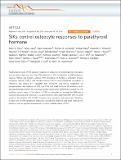SIKs control osteocyte responses to parathyroid hormone
Author(s)
Wein, Marc N.; Liang, Yanke; Goransson, Olga; Sundberg, Thomas B.; Wang, Jinhua; Williams, Elizabeth A.; O’Meara, Maureen J.; Govea, Nicolas; Beqo, Belinda; Nishimori, Shigeki; Nagano, Kenichi; Brooks, Daniel J.; Martins, Janaina S.; Corbin, Braden; Anselmo, Anthony; Sadreyev, Ruslan; Wu, Joy Y.; Sakamoto, Kei; Foretz, Marc; Baron, Roland; Bouxsein, Mary L.; Gardella, Thomas J.; Divieti-Pajevic, Paola; Gray, Nathanael S.; Kronenberg, Henry M.; Xavier, Ramnik Joseph; ... Show more Show less
DownloadSIKs control.pdf (2.560Mb)
PUBLISHER_CC
Publisher with Creative Commons License
Creative Commons Attribution
Terms of use
Metadata
Show full item recordAbstract
Parathyroid hormone (PTH) activates receptors on osteocytes to orchestrate bone formation and resorption. Here we show that PTH inhibition of SOST (sclerostin), a WNT antagonist, requires HDAC4 and HDAC5, whereas PTH stimulation of RANKL, a stimulator of bone resorption, requires CRTC2. Salt inducible kinases (SIKs) control subcellular localization of HDAC4/5 and CRTC2. PTH regulates both HDAC4/5 and CRTC2 localization via phosphorylation and inhibition of SIK2. Like PTH, new small molecule SIK inhibitors cause decreased phosphorylation and increased nuclear translocation of HDAC4/5 and CRTC2. SIK inhibition mimics many of the effects of PTH in osteocytes as assessed by RNA-seq in cultured osteocytes and following in vivo administration. Once daily treatment with the small molecule SIK inhibitor YKL-05-099 increases bone formation and bone mass. Therefore, a major arm of PTH signalling in osteocytes involves SIK inhibition, and small molecule SIK inhibitors may be applied therapeutically to mimic skeletal effects of PTH.
Date issued
2016-10Department
Massachusetts Institute of Technology. Institute for Medical Engineering & ScienceJournal
Nature Communications
Publisher
Nature Publishing Group
Citation
Wein, Marc N. et al. “SIKs Control Osteocyte Responses to Parathyroid Hormone.” Nature Communications 7 (2016): 13176.
Version: Final published version
ISSN
2041-1723